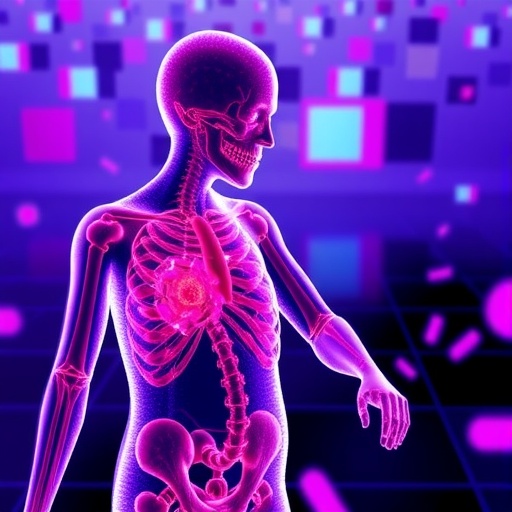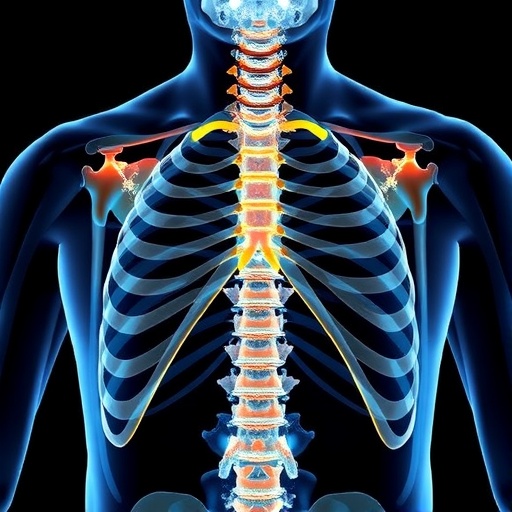In a groundbreaking advancement at the crossroads of immunology, genetics, and cancer research, scientists led by computational oncologist Dr. Benjamin Greenbaum have unveiled a sophisticated mathematical framework that quantifies a peculiar phenomenon known as viral mimicry. This discovery, rooted in repetitive DNA sequences within the human genome, offers a revolutionary lens to understand how the innate immune system detects and interacts with evolving cancer cells, promising transformative impacts on the next generation of cancer immunotherapies.
The immune system’s ability to discern between self and non-self entities is a cornerstone of its protective function. Viruses, as quintessential foreign invaders, trigger potent immune responses through pathogen-associated molecular patterns (PAMPs), molecular signatures recognized by innate immunity sensors. Intriguingly, certain repetitive sequences embedded within human DNA resemble such viral signatures. These sequences, which typically lie silent, can become transcriptionally active and produce RNA molecules that mimic viral genetic patterns—a process termed viral mimicry.
This viral mimicry phenomenon is not merely a biological curiosity; it has profound implications for cancer biology. Cancer cells, while genetically aberrant, remain derived from self but sometimes display signals that alert the immune system. Dr. Greenbaum’s research sheds light on how endogenous repetitive elements and their viral-like RNA transcripts become “flags” that the immune system recognizes as threats. This understanding opens new avenues to decode why cancer cells occasionally evade immune detection or, conversely, provoke immune-mediated destruction.
At the heart of this research is an innovative mathematical model that integrates concepts from statistical physics, machine learning, and evolutionary dynamics. Leveraging these interdisciplinary tools, the model enables quantification and characterization of viral mimicry signals across vast genomic landscapes. By delineating which repetitive element classes preferentially produce viral-like molecular patterns preserved through evolution, the model reveals how and why some genomic mimics persist while others are statistically lost.
Published in the September 24, 2025 issue of Cell Genomics, this study reflects a culmination of collaborative effort between the Greenbaum lab and an international consortium of experts. The data-driven approach demystifies the selective pressures and functional benefits shaping the landscape of endogenous viral mimicry. These repetitive DNA elements, representing nearly half of the human genome, appear to play dual roles: serving as primitive antiviral defenses and acting as sensors for cellular health disturbances.
The immunological implications are profound. Activation of these repetitive sequences—and by extension, viral mimicry—may signal cellular dysfunction or stress, essentially acting as molecular distress beacons that flag cells for immune surveillance. This could explain how the innate immune system discriminates between normal and aberrant cells, despite the latter’s “self” origin. Such signaling might be a crucial early warning system to prevent malignancies or eliminate infected and damaged cells.
Dr. Greenbaum’s team uncovered that certain classes of repeats, particularly retrotransposons, exhibit remarkable efficiency at evoking mimicry patterns recognized by innate immune receptors. Unlike random genetic noise, their preservation across evolutionary scales hints at a functional purpose, possibly rooted in ancestral viral defense systems. Understanding this interplay refines our comprehension of human genomic architecture not as static, but as dynamically intertwined with immune mechanisms.
In earlier work published in Immunity (2024), Greenbaum’s group demonstrated how pancreatic cancer cells strategically modulate these repeat elements to evade immune detection. By accommodating retrotransposon activity, cancer cells mask their immunogenic viral mimicry signals, enabling stealthy immune escape. These findings underscore the nuanced tug-of-war between tumor evolution and immune pressure—a dance choreographed at the molecular level.
The newly introduced quantitative model heralds a new frontier in cancer immunology research. By precisely measuring viral mimicry activation, researchers can dissect how oncogenic transformations alter innate immune recognition, with implications for refining checkpoint inhibitors, cell therapies, and emergent cancer vaccines. The model could inform therapeutic strategies aimed at augmenting or attenuating mimicry to modulate immune engagement.
Moreover, this research illuminates the broader landscape of innate immunity beyond oncology. Viral mimicry activated by endogenous repeats might influence autoimmunity, infectious disease responses, and cellular aging. The model’s versatility offers a foundational tool to explore diverse biological contexts where the fine balance of immune recognition and tolerance is pivotal.
Looking ahead, Dr. Greenbaum envisions translating this theoretical framework into practical applications. Enhanced ability to “tune” viral mimicry in vaccines could optimize immune activation, boosting efficacy while minimizing adverse effects. Precision measurements may enable personalized immunotherapies that harness the immune system’s nuanced detection machinery, ushering in a new era of targeted and adaptive cancer treatment.
This research exemplifies the power of interdisciplinary science — merging computational analytics, genomics, immunology, and evolutionary biology — to discern hidden patterns shaping human health. As the Greenbaum lab continues to unravel the complexities of viral mimicry, their work promises to redefine how we understand and manipulate the intimate dialogue between the immune system and cancer cells.
The unveiling of this viral mimicry quantification model marks a pivotal step toward harnessing the innate immune system’s intrinsic capabilities against cancer. Ultimately, the deeper our understanding of these ancient molecular signals, the better equipped we become to tip the scales in favor of immune-mediated tumor control and long-term patient survival.
Subject of Research: Cells
Article Title: Repeats mimic pathogen-associated patterns across a vast evolutionary landscape
News Publication Date: 24-Sep-2025
Web References: http://dx.doi.org/10.1016/j.xgen.2025.101011
References: Greenbaum, B. et al. (2025). Repeats mimic pathogen-associated patterns across a vast evolutionary landscape. Cell Genomics. DOI: 10.1016/j.xgen.2025.101011
Keywords: Computational biology, viral mimicry, repetitive DNA, innate immunity, cancer immunotherapy, retrotransposons, pathogen-associated molecular patterns, mathematical modeling, cancer evolution, immuno-oncology
Tags: cancer immunotherapies advancementsDr. Benjamin Greenbaum researchimmune system and cancer interactionimplications of viral mimicryinnate immune system and cancermathematical framework in immunologypathogen-associated molecular patterns in oncologyrepetitive DNA sequences in cancerRNA molecules and cancer detectionself vs non-self in immune responsetransformative cancer research breakthroughsviral mimicry in cancer progression





